ACC202 Management Accounting: Multinational Transfer Pricing Analysis
VerifiedAdded on 2023/06/11
|9
|1196
|193
Report
AI Summary
This management accounting report addresses multinational transfer pricing strategies for global tax minimization and goal congruence, along with airline pricing strategies. It analyzes the feasibility of different transfer pricing approaches for Derwent Limited, considering import duties and income tax implications. The report also evaluates airline pricing strategies for Eastcoast Airways, recommending price discrimination between pleasure and business travelers to maximize contribution margin. The analysis excludes certain costs deemed irrelevant to pricing strategy changes, such as lease, fuel, and ground service costs. The study concludes that price discrimination can significantly benefit the airline while remaining legally compliant.
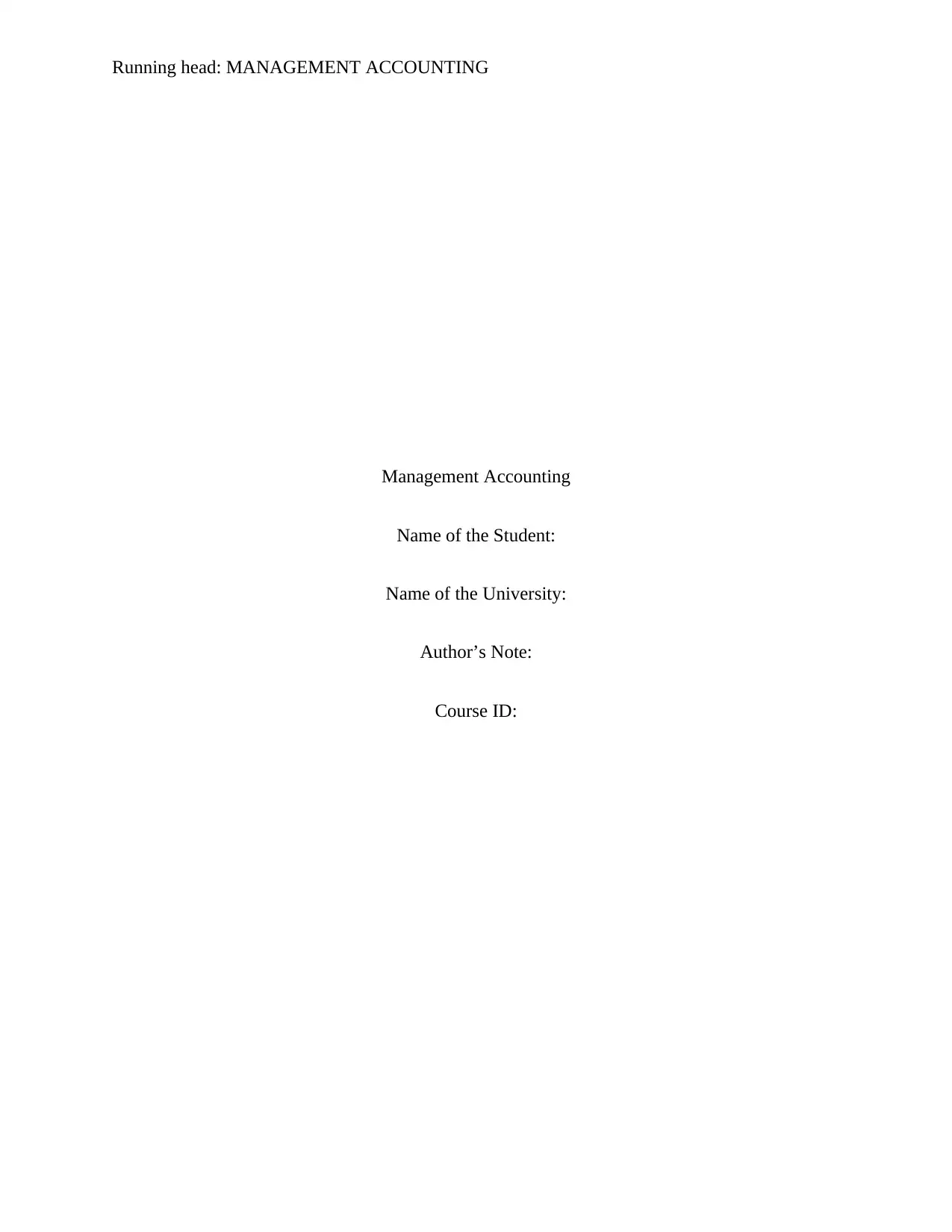
Running head: MANAGEMENT ACCOUNTING
Management Accounting
Name of the Student:
Name of the University:
Author’s Note:
Course ID:
Management Accounting
Name of the Student:
Name of the University:
Author’s Note:
Course ID:
Paraphrase This Document
Need a fresh take? Get an instant paraphrase of this document with our AI Paraphraser
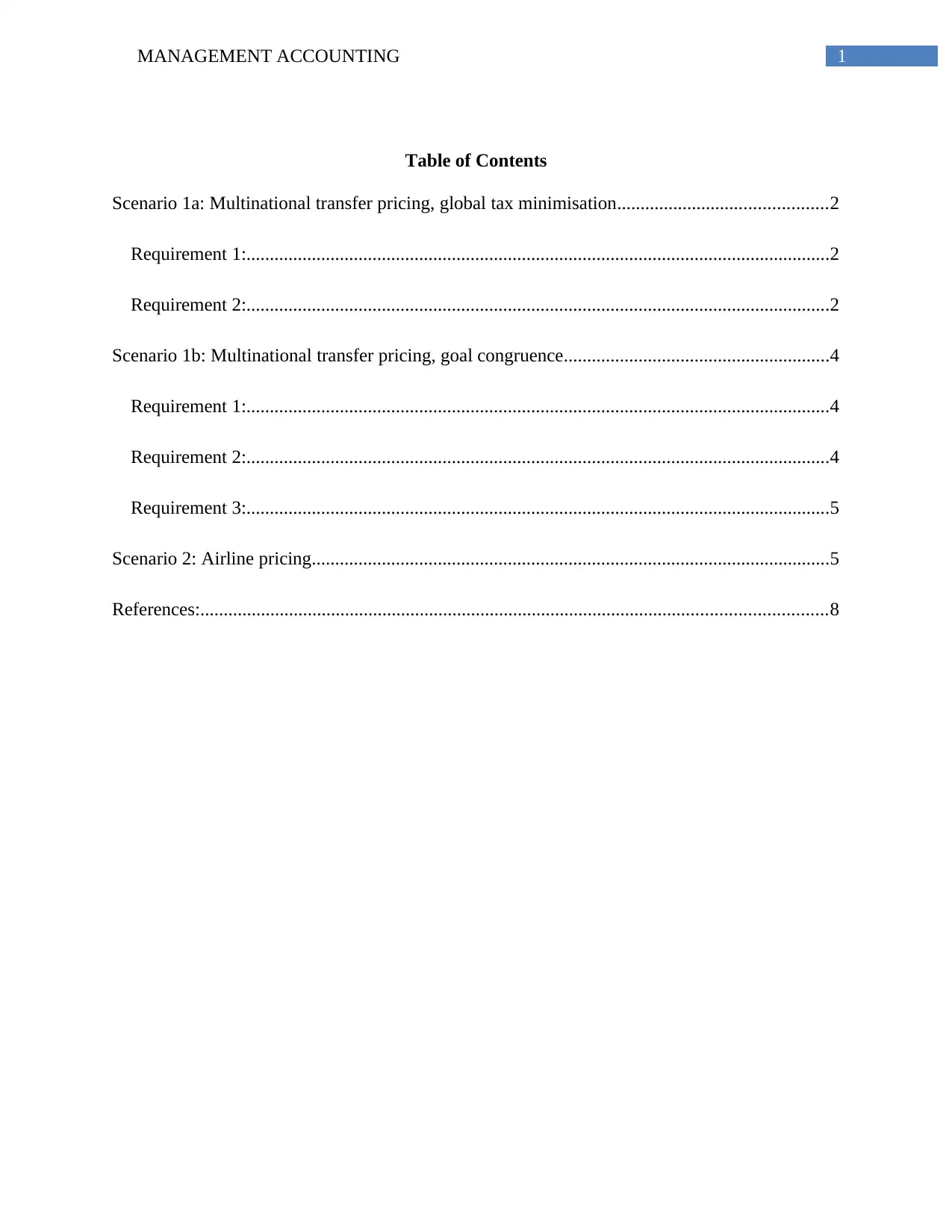
1MANAGEMENT ACCOUNTING
Table of Contents
Scenario 1a: Multinational transfer pricing, global tax minimisation.............................................2
Requirement 1:.............................................................................................................................2
Requirement 2:.............................................................................................................................2
Scenario 1b: Multinational transfer pricing, goal congruence.........................................................4
Requirement 1:.............................................................................................................................4
Requirement 2:.............................................................................................................................4
Requirement 3:.............................................................................................................................5
Scenario 2: Airline pricing...............................................................................................................5
References:......................................................................................................................................8
Table of Contents
Scenario 1a: Multinational transfer pricing, global tax minimisation.............................................2
Requirement 1:.............................................................................................................................2
Requirement 2:.............................................................................................................................2
Scenario 1b: Multinational transfer pricing, goal congruence.........................................................4
Requirement 1:.............................................................................................................................4
Requirement 2:.............................................................................................................................4
Requirement 3:.............................................................................................................................5
Scenario 2: Airline pricing...............................................................................................................5
References:......................................................................................................................................8
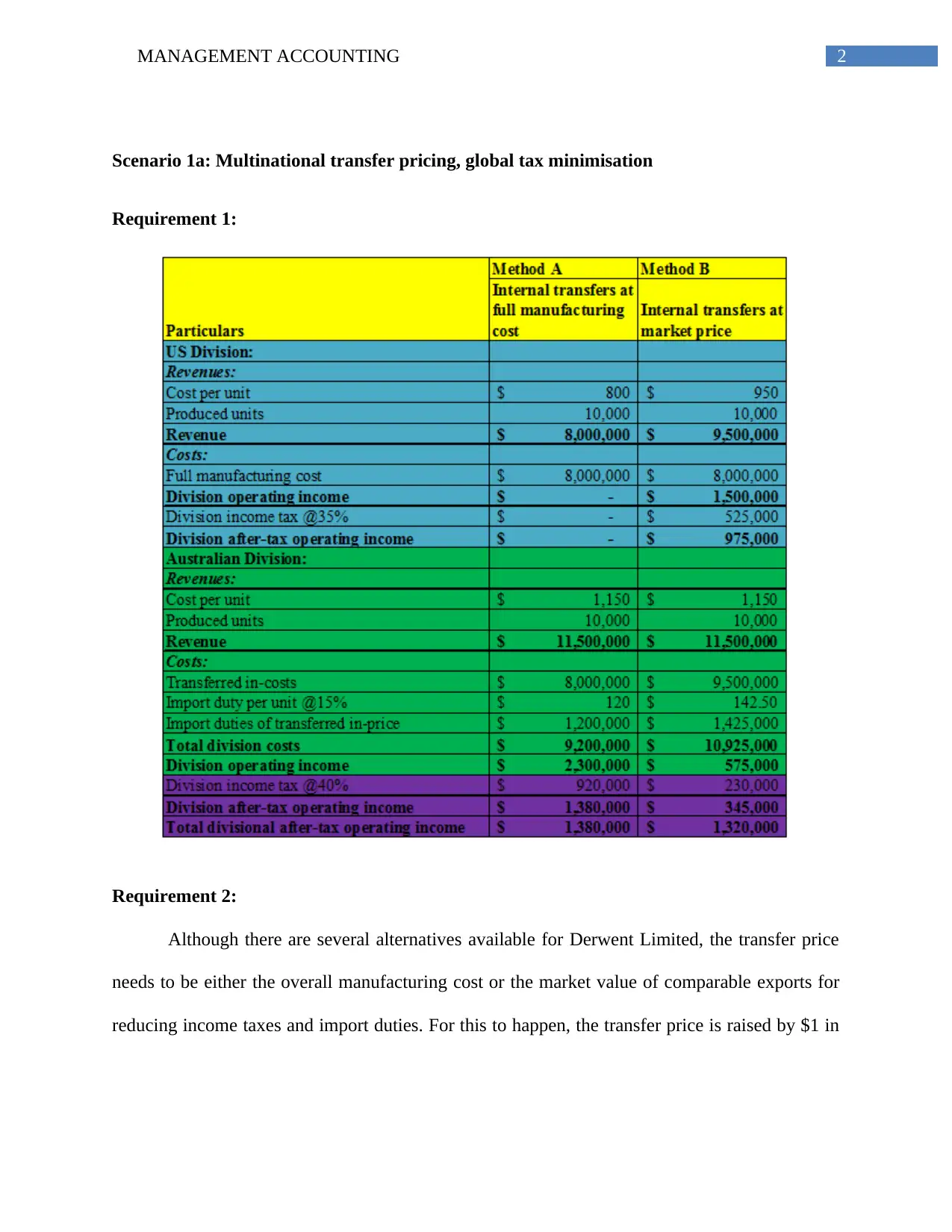
2MANAGEMENT ACCOUNTING
Scenario 1a: Multinational transfer pricing, global tax minimisation
Requirement 1:
Requirement 2:
Although there are several alternatives available for Derwent Limited, the transfer price
needs to be either the overall manufacturing cost or the market value of comparable exports for
reducing income taxes and import duties. For this to happen, the transfer price is raised by $1 in
Scenario 1a: Multinational transfer pricing, global tax minimisation
Requirement 1:
Requirement 2:
Although there are several alternatives available for Derwent Limited, the transfer price
needs to be either the overall manufacturing cost or the market value of comparable exports for
reducing income taxes and import duties. For this to happen, the transfer price is raised by $1 in
⊘ This is a preview!⊘
Do you want full access?
Subscribe today to unlock all pages.

Trusted by 1+ million students worldwide
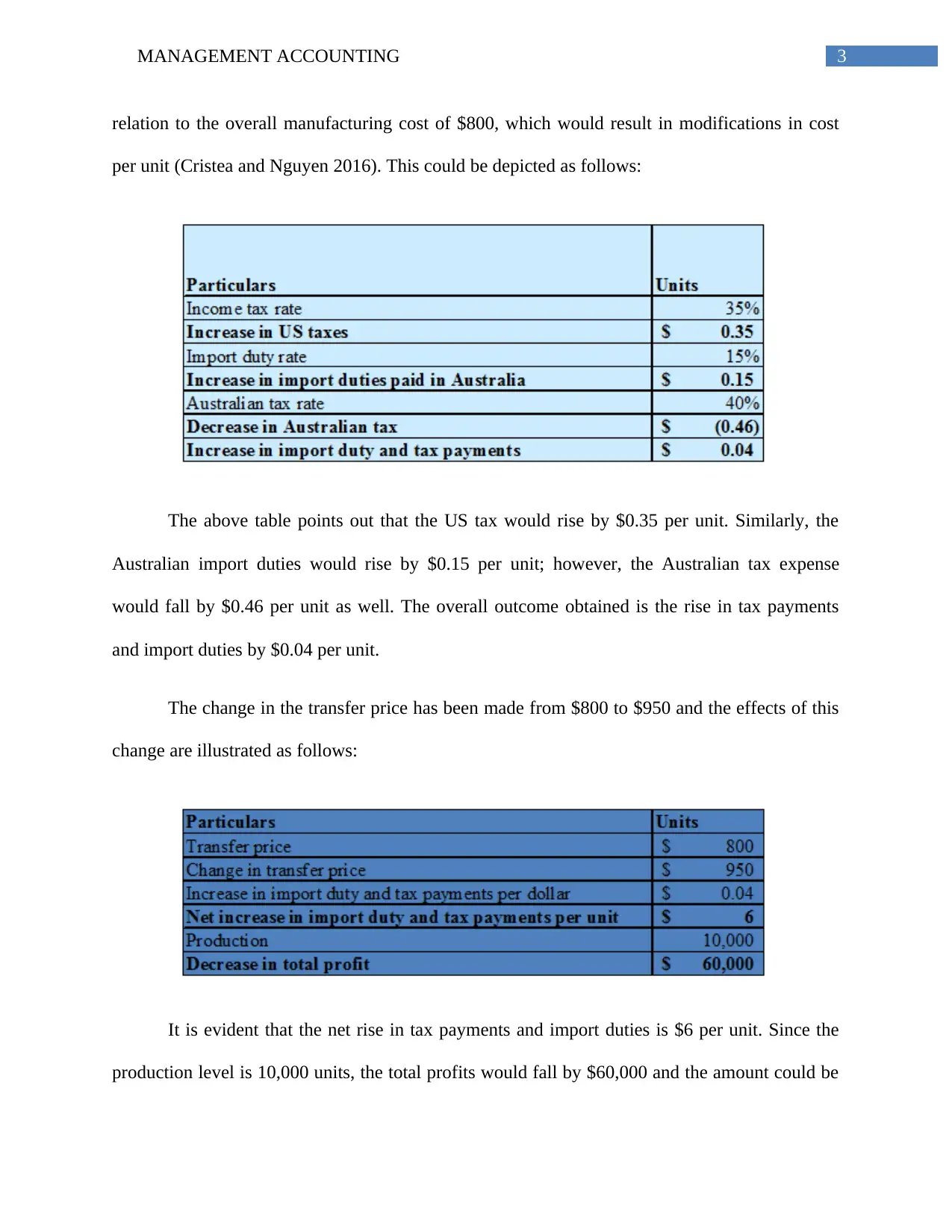
3MANAGEMENT ACCOUNTING
relation to the overall manufacturing cost of $800, which would result in modifications in cost
per unit (Cristea and Nguyen 2016). This could be depicted as follows:
The above table points out that the US tax would rise by $0.35 per unit. Similarly, the
Australian import duties would rise by $0.15 per unit; however, the Australian tax expense
would fall by $0.46 per unit as well. The overall outcome obtained is the rise in tax payments
and import duties by $0.04 per unit.
The change in the transfer price has been made from $800 to $950 and the effects of this
change are illustrated as follows:
It is evident that the net rise in tax payments and import duties is $6 per unit. Since the
production level is 10,000 units, the total profits would fall by $60,000 and the amount could be
relation to the overall manufacturing cost of $800, which would result in modifications in cost
per unit (Cristea and Nguyen 2016). This could be depicted as follows:
The above table points out that the US tax would rise by $0.35 per unit. Similarly, the
Australian import duties would rise by $0.15 per unit; however, the Australian tax expense
would fall by $0.46 per unit as well. The overall outcome obtained is the rise in tax payments
and import duties by $0.04 per unit.
The change in the transfer price has been made from $800 to $950 and the effects of this
change are illustrated as follows:
It is evident that the net rise in tax payments and import duties is $6 per unit. Since the
production level is 10,000 units, the total profits would fall by $60,000 and the amount could be
Paraphrase This Document
Need a fresh take? Get an instant paraphrase of this document with our AI Paraphraser
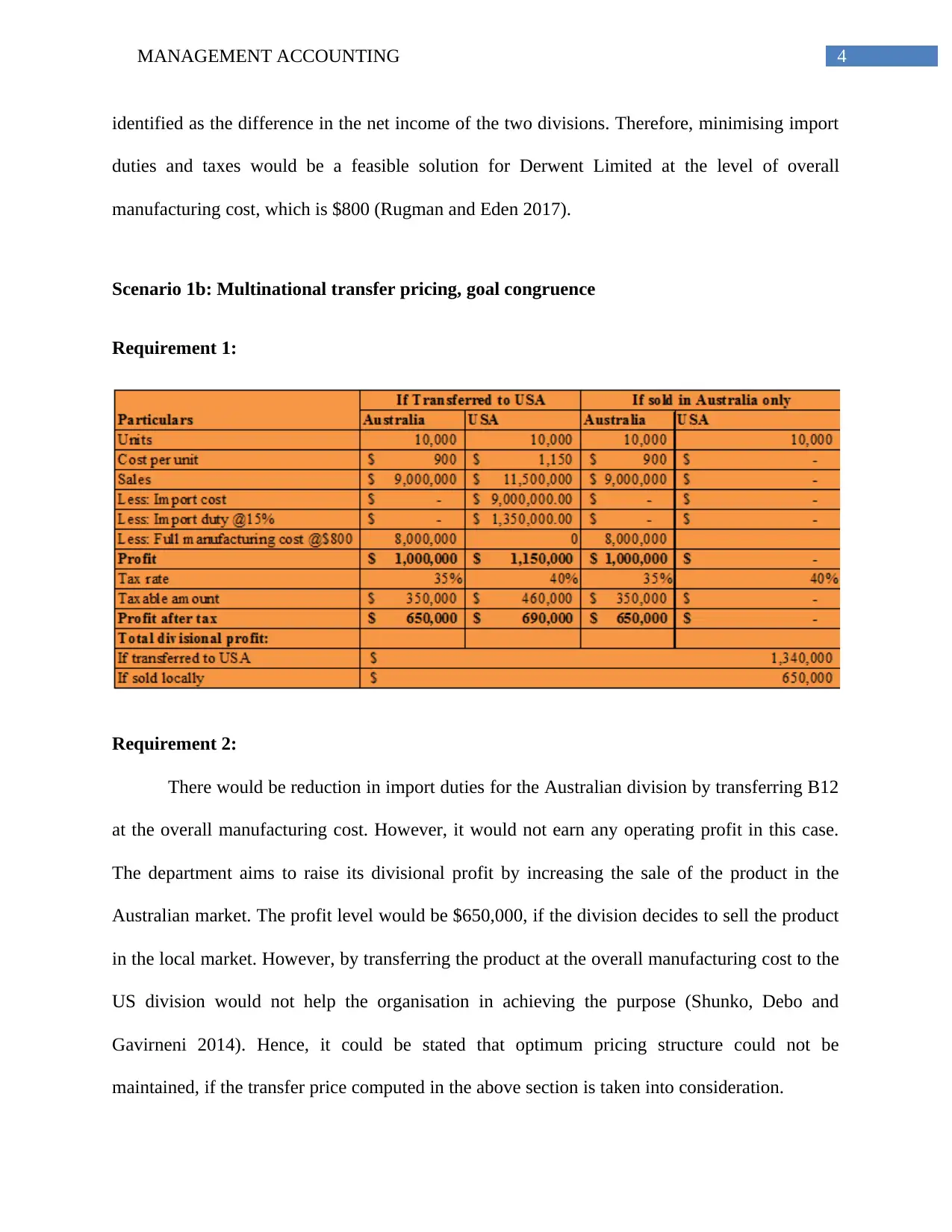
4MANAGEMENT ACCOUNTING
identified as the difference in the net income of the two divisions. Therefore, minimising import
duties and taxes would be a feasible solution for Derwent Limited at the level of overall
manufacturing cost, which is $800 (Rugman and Eden 2017).
Scenario 1b: Multinational transfer pricing, goal congruence
Requirement 1:
Requirement 2:
There would be reduction in import duties for the Australian division by transferring B12
at the overall manufacturing cost. However, it would not earn any operating profit in this case.
The department aims to raise its divisional profit by increasing the sale of the product in the
Australian market. The profit level would be $650,000, if the division decides to sell the product
in the local market. However, by transferring the product at the overall manufacturing cost to the
US division would not help the organisation in achieving the purpose (Shunko, Debo and
Gavirneni 2014). Hence, it could be stated that optimum pricing structure could not be
maintained, if the transfer price computed in the above section is taken into consideration.
identified as the difference in the net income of the two divisions. Therefore, minimising import
duties and taxes would be a feasible solution for Derwent Limited at the level of overall
manufacturing cost, which is $800 (Rugman and Eden 2017).
Scenario 1b: Multinational transfer pricing, goal congruence
Requirement 1:
Requirement 2:
There would be reduction in import duties for the Australian division by transferring B12
at the overall manufacturing cost. However, it would not earn any operating profit in this case.
The department aims to raise its divisional profit by increasing the sale of the product in the
Australian market. The profit level would be $650,000, if the division decides to sell the product
in the local market. However, by transferring the product at the overall manufacturing cost to the
US division would not help the organisation in achieving the purpose (Shunko, Debo and
Gavirneni 2014). Hence, it could be stated that optimum pricing structure could not be
maintained, if the transfer price computed in the above section is taken into consideration.
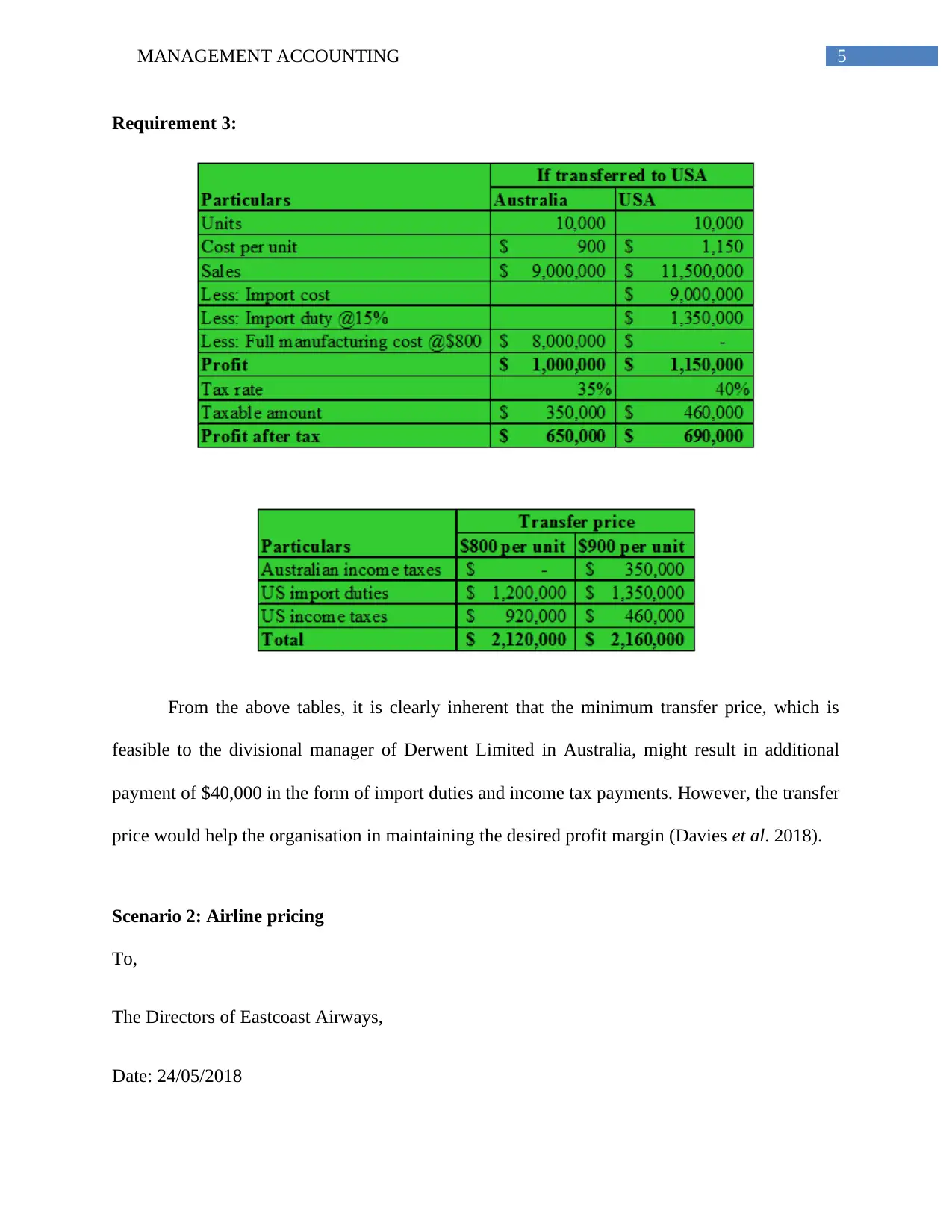
5MANAGEMENT ACCOUNTING
Requirement 3:
From the above tables, it is clearly inherent that the minimum transfer price, which is
feasible to the divisional manager of Derwent Limited in Australia, might result in additional
payment of $40,000 in the form of import duties and income tax payments. However, the transfer
price would help the organisation in maintaining the desired profit margin (Davies et al. 2018).
Scenario 2: Airline pricing
To,
The Directors of Eastcoast Airways,
Date: 24/05/2018
Requirement 3:
From the above tables, it is clearly inherent that the minimum transfer price, which is
feasible to the divisional manager of Derwent Limited in Australia, might result in additional
payment of $40,000 in the form of import duties and income tax payments. However, the transfer
price would help the organisation in maintaining the desired profit margin (Davies et al. 2018).
Scenario 2: Airline pricing
To,
The Directors of Eastcoast Airways,
Date: 24/05/2018
⊘ This is a preview!⊘
Do you want full access?
Subscribe today to unlock all pages.

Trusted by 1+ million students worldwide
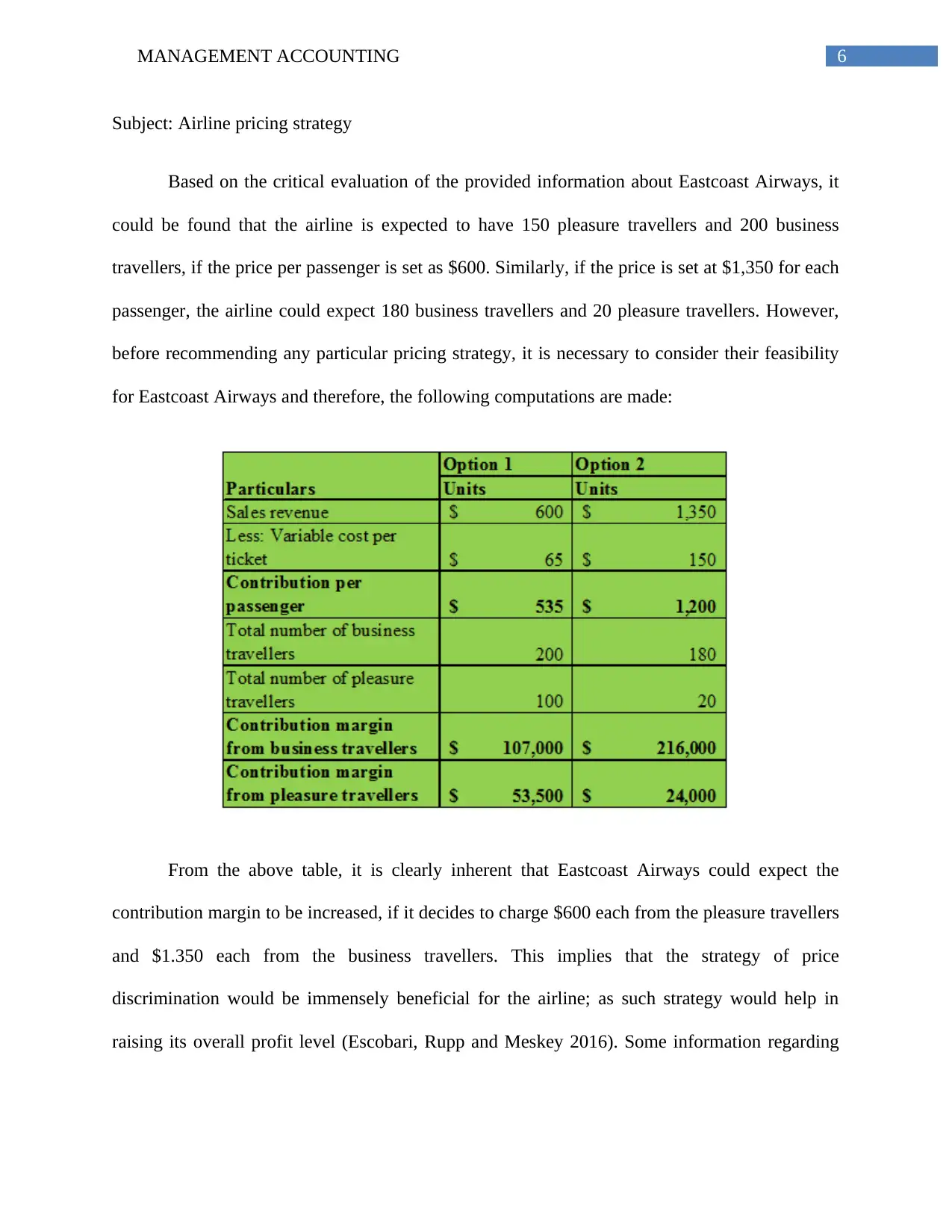
6MANAGEMENT ACCOUNTING
Subject: Airline pricing strategy
Based on the critical evaluation of the provided information about Eastcoast Airways, it
could be found that the airline is expected to have 150 pleasure travellers and 200 business
travellers, if the price per passenger is set as $600. Similarly, if the price is set at $1,350 for each
passenger, the airline could expect 180 business travellers and 20 pleasure travellers. However,
before recommending any particular pricing strategy, it is necessary to consider their feasibility
for Eastcoast Airways and therefore, the following computations are made:
From the above table, it is clearly inherent that Eastcoast Airways could expect the
contribution margin to be increased, if it decides to charge $600 each from the pleasure travellers
and $1.350 each from the business travellers. This implies that the strategy of price
discrimination would be immensely beneficial for the airline; as such strategy would help in
raising its overall profit level (Escobari, Rupp and Meskey 2016). Some information regarding
Subject: Airline pricing strategy
Based on the critical evaluation of the provided information about Eastcoast Airways, it
could be found that the airline is expected to have 150 pleasure travellers and 200 business
travellers, if the price per passenger is set as $600. Similarly, if the price is set at $1,350 for each
passenger, the airline could expect 180 business travellers and 20 pleasure travellers. However,
before recommending any particular pricing strategy, it is necessary to consider their feasibility
for Eastcoast Airways and therefore, the following computations are made:
From the above table, it is clearly inherent that Eastcoast Airways could expect the
contribution margin to be increased, if it decides to charge $600 each from the pleasure travellers
and $1.350 each from the business travellers. This implies that the strategy of price
discrimination would be immensely beneficial for the airline; as such strategy would help in
raising its overall profit level (Escobari, Rupp and Meskey 2016). Some information regarding
Paraphrase This Document
Need a fresh take? Get an instant paraphrase of this document with our AI Paraphraser
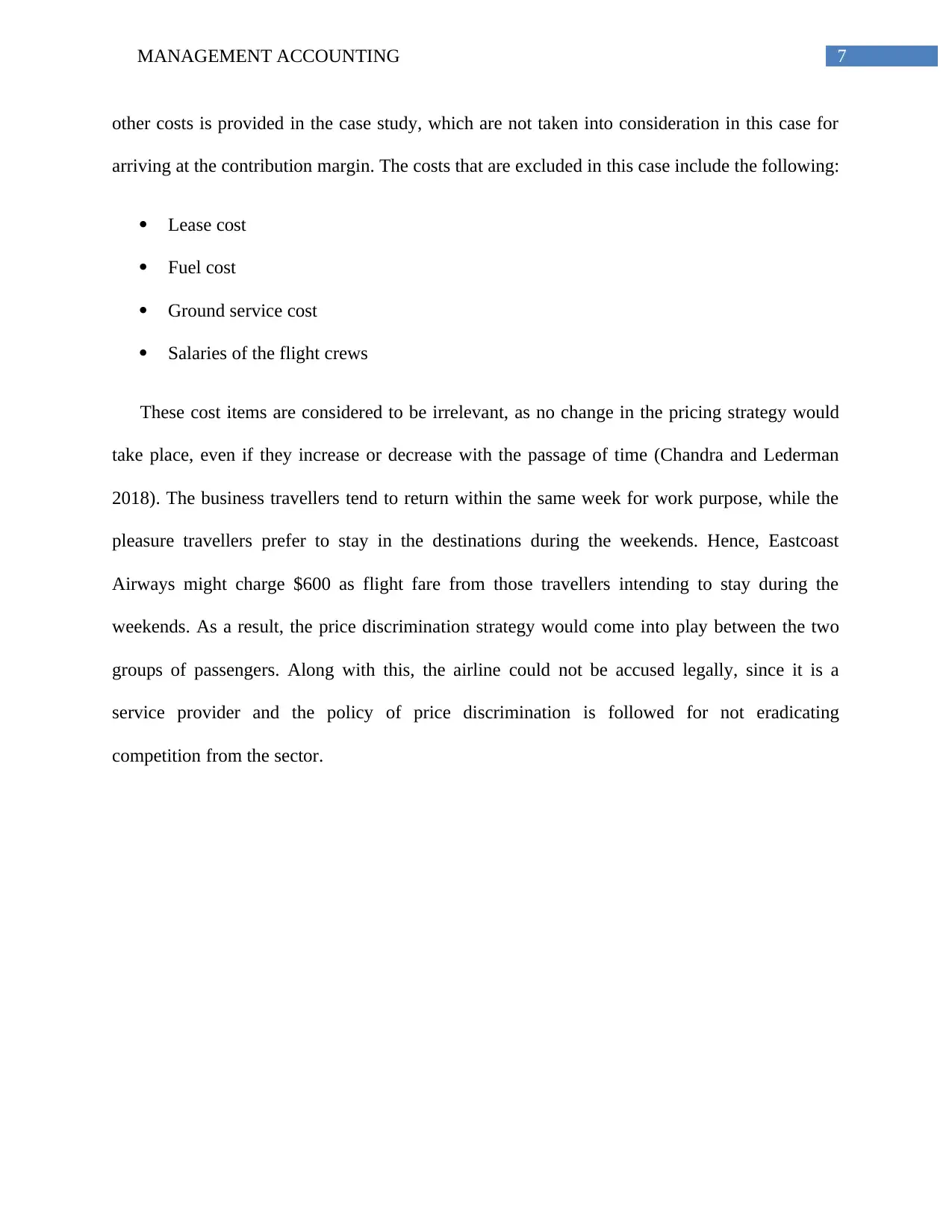
7MANAGEMENT ACCOUNTING
other costs is provided in the case study, which are not taken into consideration in this case for
arriving at the contribution margin. The costs that are excluded in this case include the following:
Lease cost
Fuel cost
Ground service cost
Salaries of the flight crews
These cost items are considered to be irrelevant, as no change in the pricing strategy would
take place, even if they increase or decrease with the passage of time (Chandra and Lederman
2018). The business travellers tend to return within the same week for work purpose, while the
pleasure travellers prefer to stay in the destinations during the weekends. Hence, Eastcoast
Airways might charge $600 as flight fare from those travellers intending to stay during the
weekends. As a result, the price discrimination strategy would come into play between the two
groups of passengers. Along with this, the airline could not be accused legally, since it is a
service provider and the policy of price discrimination is followed for not eradicating
competition from the sector.
other costs is provided in the case study, which are not taken into consideration in this case for
arriving at the contribution margin. The costs that are excluded in this case include the following:
Lease cost
Fuel cost
Ground service cost
Salaries of the flight crews
These cost items are considered to be irrelevant, as no change in the pricing strategy would
take place, even if they increase or decrease with the passage of time (Chandra and Lederman
2018). The business travellers tend to return within the same week for work purpose, while the
pleasure travellers prefer to stay in the destinations during the weekends. Hence, Eastcoast
Airways might charge $600 as flight fare from those travellers intending to stay during the
weekends. As a result, the price discrimination strategy would come into play between the two
groups of passengers. Along with this, the airline could not be accused legally, since it is a
service provider and the policy of price discrimination is followed for not eradicating
competition from the sector.
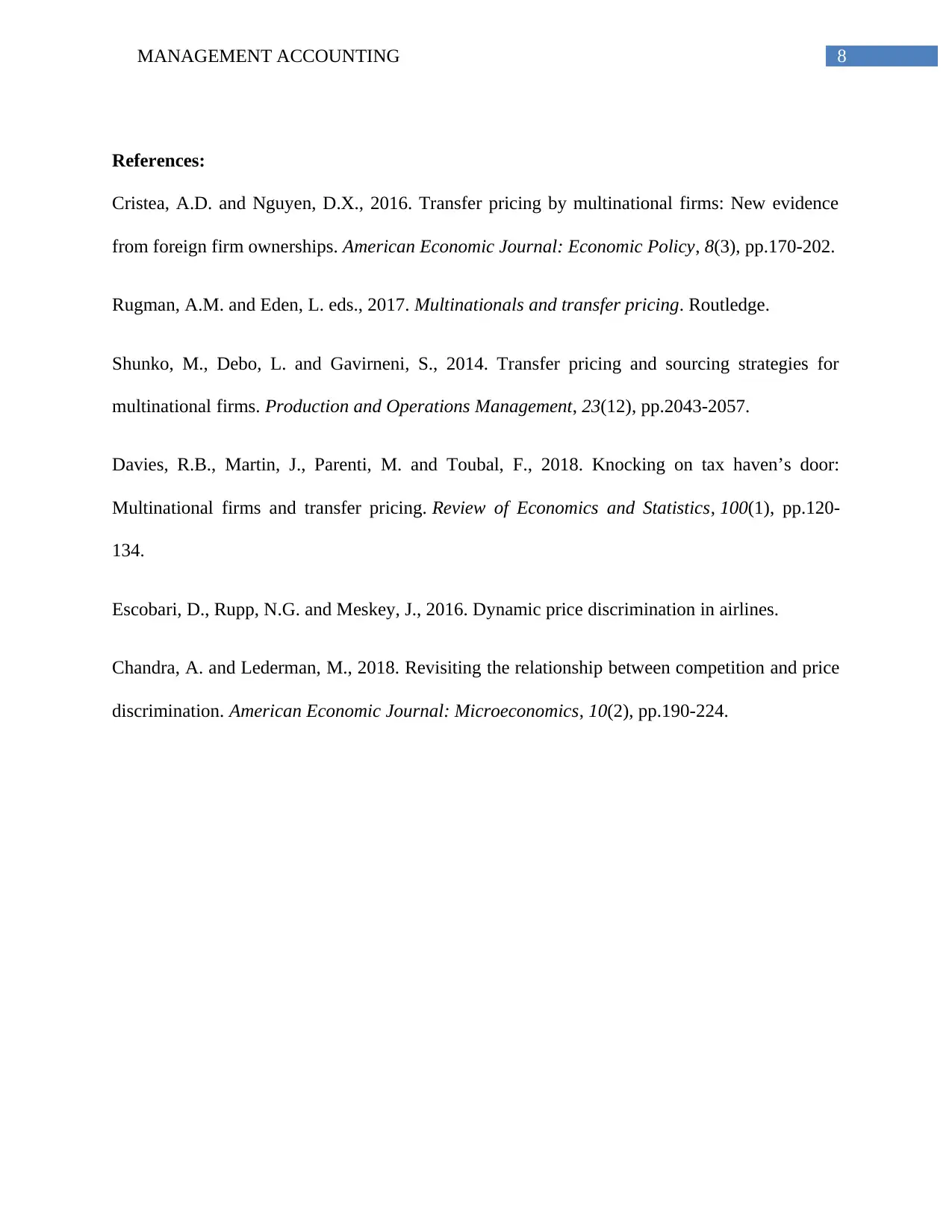
8MANAGEMENT ACCOUNTING
References:
Cristea, A.D. and Nguyen, D.X., 2016. Transfer pricing by multinational firms: New evidence
from foreign firm ownerships. American Economic Journal: Economic Policy, 8(3), pp.170-202.
Rugman, A.M. and Eden, L. eds., 2017. Multinationals and transfer pricing. Routledge.
Shunko, M., Debo, L. and Gavirneni, S., 2014. Transfer pricing and sourcing strategies for
multinational firms. Production and Operations Management, 23(12), pp.2043-2057.
Davies, R.B., Martin, J., Parenti, M. and Toubal, F., 2018. Knocking on tax haven’s door:
Multinational firms and transfer pricing. Review of Economics and Statistics, 100(1), pp.120-
134.
Escobari, D., Rupp, N.G. and Meskey, J., 2016. Dynamic price discrimination in airlines.
Chandra, A. and Lederman, M., 2018. Revisiting the relationship between competition and price
discrimination. American Economic Journal: Microeconomics, 10(2), pp.190-224.
References:
Cristea, A.D. and Nguyen, D.X., 2016. Transfer pricing by multinational firms: New evidence
from foreign firm ownerships. American Economic Journal: Economic Policy, 8(3), pp.170-202.
Rugman, A.M. and Eden, L. eds., 2017. Multinationals and transfer pricing. Routledge.
Shunko, M., Debo, L. and Gavirneni, S., 2014. Transfer pricing and sourcing strategies for
multinational firms. Production and Operations Management, 23(12), pp.2043-2057.
Davies, R.B., Martin, J., Parenti, M. and Toubal, F., 2018. Knocking on tax haven’s door:
Multinational firms and transfer pricing. Review of Economics and Statistics, 100(1), pp.120-
134.
Escobari, D., Rupp, N.G. and Meskey, J., 2016. Dynamic price discrimination in airlines.
Chandra, A. and Lederman, M., 2018. Revisiting the relationship between competition and price
discrimination. American Economic Journal: Microeconomics, 10(2), pp.190-224.
⊘ This is a preview!⊘
Do you want full access?
Subscribe today to unlock all pages.

Trusted by 1+ million students worldwide
1 out of 9
Related Documents
Your All-in-One AI-Powered Toolkit for Academic Success.
+13062052269
info@desklib.com
Available 24*7 on WhatsApp / Email
![[object Object]](/_next/static/media/star-bottom.7253800d.svg)
Unlock your academic potential
Copyright © 2020–2025 A2Z Services. All Rights Reserved. Developed and managed by ZUCOL.





